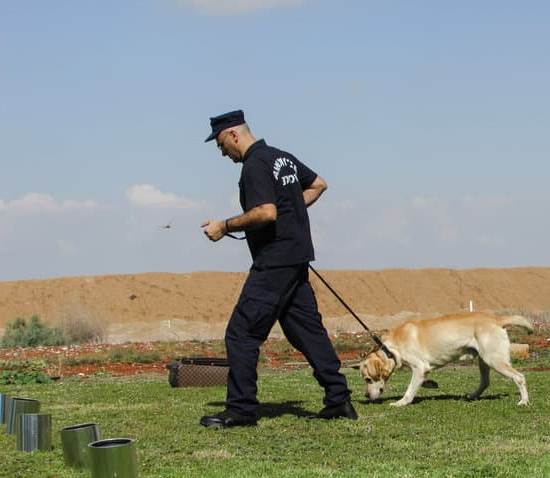Heel dog training is an essential skill for every dog owner to master. It involves teaching your canine companion to walk politely by your side, without pulling on the leash or lunging towards distractions. In this introductory section, we will delve into the fundamentals of heel dog training and why it is crucial for you and your furry friend.
Proper leash manners and control are vital aspects of owning a well-behaved dog. Heel training provides you with the tools to establish clear communication and leadership with your pet. By teaching your dog to walk attentively by your side, you create a harmonious bond built on trust and respect.
The benefits of heel training go beyond just polite walks; it also enhances daily outings and social interactions. Imagine being able to enjoy a leisurely walk in the park without tugging or barking every few steps. By mastering heel dog training, you can confidently navigate various environments with ease, making both yours and your dog’s experiences more enjoyable.
Why Heel Dog Training is Essential for a Well-Behaved Canine Companion
Heel dog training is not just about teaching your dog to walk politely by your side. It is a fundamental aspect of obedience training that can significantly improve the overall behavior and manners of your canine companion.
When a dog learns to heel, it develops a stronger bond with its owner and gains better control over impulsive behaviors. This section will discuss the correlation between heel training and overall obedience, how heel training improves the dog-owner bond, and examples of how heel training can enhance daily walks and outings.
One of the reasons why heel dog training is essential for a well-behaved canine companion is its direct impact on overall obedience. When a dog understands and follows the command to “heel,” it learns to listen and respond to other commands as well. Heel training helps establish you as the pack leader, teaching your dog impulse control, focus, and responsiveness. By mastering heel training, your dog becomes more attentive and obedient in other aspects of its life.
In addition to improving obedience, heel dog training also strengthens the bond between you and your furry friend. During training sessions, you work together as a team towards a common goal, building trust, communication, and mutual understanding. The time spent on teaching your dog to heel creates opportunities for positive reinforcement and rewards, further enhancing the emotional connection between you.
Moreover, heel training can greatly enhance daily walks and outings with your canine companion. Instead of having a dog that pulls or lunges ahead on the leash, you can enjoy a calm and enjoyable walk side by side. Heel-trained dogs are less likely to be reactive towards distractions or exhibit unwanted behaviors such as jumping or barking at other dogs or people they encounter during walks.
| Benefits of Heel Dog Training |
|---|
| Improved obedience |
| Stronger bond between owner and dog |
| Enhanced walking experiences with less pulling or reactivity |
Different Techniques and Approaches to Heel Dog Training
When it comes to heel dog training, there are various techniques and approaches that can be used to achieve the desired results. Each method has its own advantages and disadvantages, and it’s important for dog owners to choose the approach that works best for their individual dog. In this section, we will explore some of the different techniques and approaches to heel dog training.
One popular method is positive reinforcement training. This involves rewarding your dog with treats, praise, or other rewards when they exhibit the desired behavior of walking calmly by your side. Positive reinforcement training focuses on encouraging good behavior rather than punishing unwanted behavior, which can lead to a stronger bond between you and your dog.
Another approach is clicker training. Clicker training involves using a clicker device that makes a distinct sound when pressed to mark the correct behavior. With consistent practice, dogs learn to associate the sound of the clicker with a reward, making it an effective tool for teaching them to walk at your side.
Leash corrections are another technique commonly used in heel dog training. This involves giving a quick tug or correction on the leash when your dog starts to pull or drift away from your side. The correction should be firm but not aggressive, and should be followed by immediate praise and reward when your dog resumes walking calmly at your side.
In addition to these training techniques, there are also various tools that can be used in heel dog training. Head halters, for example, can help provide better control over your dog’s head movements during walks. Harnesses can also be useful in providing more leverage and control while maintaining comfort for your dog.
It’s important for dog owners to carefully consider which techniques and tools align with their own training philosophies and their individual dog’s needs. It may also be helpful to consult with a professional trainer or behaviorist who can provide guidance and support tailored to your specific situation.
| Technique | Advantages | Disadvantages |
|---|---|---|
| Positive Reinforcement Training | – Encourages a strong bond between dog and owner
| – May require more time and patience for some dogs to learn
|
| Clicker Training | – Clear and distinct marking of desired behavior
| – Requires consistent use of the clicker device
|
| Leash Corrections | – Provides immediate feedback when dog starts to pull or drift away
| – Requires proper timing and technique for effective correction
|
Step-by-Step Guide
Teaching your dog to heel is an important aspect of training that can enhance your overall relationship and ensure a well-behaved canine companion. By following a step-by-step guide, you can effectively teach your dog to walk calmly by your side and respond to your commands. Here is a breakdown of the training process:
Start with Basic Obedience Commands
Before diving into heel training, make sure your dog understands basic obedience commands such as sit, stay, and come. This foundation will help set the stage for successful heel training.
Choose the Right Equipment
Using the right equipment is crucial for effective heel training. Opt for a collar or harness that fits your dog comfortably without causing any discomfort or harm.
Begin in a Low-Distraction Environment
Start the training process in a quiet and familiar space such as your backyard. This will minimize distractions and allow your dog to focus on learning the desired behavior.
Introduce the Heel Position
Hold a treat or toy near your left leg and encourage your dog to walk beside you on your left side. Use verbal cues like “heel” or “walk” to associate the behavior with a command.
Reward and Reinforce Good Behavior
As soon as your dog starts walking by your side without pulling or straying, reward them with praise, treats, or playtime. Consistently reinforce this behavior to make it a positive habit.
Practice in Increasingly Challenging Environments
Gradually introduce distractions such as other animals, people, or noise during practice sessions. This will help desensitize your dog and strengthen their focus on you even in stimulating environments.
Utilize Leash Corrections (if needed)
If your dog starts to pull or drift away from the heel position, use gentle leash corrections to guide them back into place. Avoid yanking on the leash or using excessive force, as this can hinder your progress.
Gradually Lengthen Training Sessions
As your dog becomes more proficient in heel training, increase the duration of your training sessions. Aim for consistency and regular practice to reinforce the desired behavior.
Remember that each dog learns at their own pace, so be patient and adjust your approach accordingly. With time, practice, and positive reinforcement, your dog will become a well-behaved and reliable companion during walks and outings.
The Role of Consistency and Patience in Heel Dog Training
Consistency and patience play a crucial role in heel dog training. When it comes to teaching your dog to heel, it is essential to maintain consistent practice and reinforcement. Consistency ensures that your dog understands what is expected of them and reinforces the desired behavior. Without consistency, your dog may become confused or revert back to old habits.
Consistent practice involves incorporating heel training into your daily routine. Set aside specific times for training sessions and be diligent in sticking to them. Consistency also means using the same cues, gestures, and rewards each time you train your dog to heel. This helps establish clear communication between you and your canine companion.
Patience is equally important in heel dog training. Dogs learn at their own pace, so it’s crucial to be patient with their progress. Rushing the process or becoming frustrated can hinder their learning and potentially create a negative association with training.
During training sessions, remain calm and composed even if your dog makes mistakes or struggles with certain aspects of heel training. Keep in mind that every small step forward is a step in the right direction. Celebrate even the smallest achievements, such as walking a few steps without pulling on the leash. By staying patient and positive, you create an environment that encourages learning and cooperation.
It’s important to remember that each dog is unique and may require different amounts of time and repetition to grasp the concept of heeling consistently. Some dogs may pick up on the training quickly, while others may need more time to understand and become comfortable with the behavior.
In summary, consistency and patience are vital components of successful heel dog training. By maintaining consistent practice, using clear cues, gestures, and rewards, as well as remaining patient throughout the process, you set your furry friend up for success. Remember that building these skills takes time but that every small achievement brings you closer to having a well-behaved pet who walks politely by your side.
Advanced Heel Dog Training Techniques for Advanced Training Needs
Exploring off-leash heel training
One advanced technique in heel dog training is off-leash training. This involves teaching your dog to maintain a heeling position without the use of a leash. Off-leash heel training requires a higher level of obedience and focus from your canine companion, as they must follow your commands without the physical restriction of a leash.
To begin off-leash heel training, it is important to ensure that your dog has mastered on-leash heel training first. This foundation helps establish boundaries and reinforces the desired behavior before transitioning to off-leash work. Gradually increase the distance between you and your dog while maintaining the heeling position. Use verbal cues and hand signals to guide your dog, and reward them with praise or treats for correct responses.
It’s essential to practice off-leash heel training in a safe and controlled environment such as a securely fenced area or an open space with minimal distractions. Remember that off-leash training takes time and patience, so start slowly and gradually build up the level of difficulty as your dog becomes more reliable.
Introducing distance commands
Another advanced technique in heel dog training is teaching distance commands. Distance commands go beyond basic heeling on walks by allowing you to control your dog’s movement from a distance without physically being next to them.
To introduce distance commands, it is crucial to have established a strong foundation in on-leash and off-leash heel training. Start by reinforcing fundamental verbal cues such as “sit,” “stay,” or “come” while maintaining the heeling position at different distances. Practice these commands first in low-distraction environments and gradually increase the level of difficulty by adding distractions or increasing distances.
Consistency is key when teaching distance commands in heel dog training. Make sure you maintain clear communication with your canine companion through consistent voice tones, hand signals, or whistle signals. Reward correct responses and provide reinforcement to ensure your dog understands the desired behavior.
Overcoming challenges in advanced heel dog training
Advanced heel dog training techniques may come with their fair share of challenges. As you progress to off-leash and distance commands, distractions become more tempting for your dog, making it challenging to maintain focus. It is important to build up distractions gradually, starting with low-level distractions and gradually working up to more challenging ones.
If your dog displays stubborn behavior or struggles with advanced techniques, it may be beneficial to seek professional assistance. Certified trainers specializing in obedience training or canine sports can provide guidance tailored to your specific needs and help overcome any obstacles you encounter during advanced heel dog training.
Remember that advanced techniques require patience, consistency, and dedication from both you and your canine companion. Celebrate small victories along the way and embrace the learning process as you work towards a well-behaved, obedient, and happy canine companion.
Troubleshooting Common Issues in Heel Dog Training
Addressing Leash Pulling
One of the most common issues dog owners face during heel dog training is leash pulling. It can be frustrating when your dog constantly pulls ahead, making it difficult to maintain control and a proper walking pace. To address this problem, it’s important to implement strategies that encourage your dog to walk calmly by your side.
One effective technique is to stop moving whenever your dog starts pulling on the leash. This teaches them that pulling won’t get them where they want to go and that they need to stay close to you for the walk to continue. Additionally, you can use positive reinforcement by rewarding your dog with treats and praise when they walk alongside you without pulling.
Dealing with Distractions
Distractions are another challenge in heel dog training. Dogs naturally have curious minds and may be easily enticed by smells, other animals, or even people walking by. It’s crucial to teach your dog to remain focused on you during walks and outings.
One useful technique is incorporating “watch me” commands into your training sessions. Start by getting your dog’s attention with a treat held close to their nose, then slowly move the treat towards your face while saying “watch me.” When your dog maintains eye contact with you, reward them with the treat. Gradually increase the duration of eye contact before offering the reward.
Overcoming Stubborn Behavior
Some dogs may exhibit stubborn behavior during heel training, refusing to listen or follow instructions. Patience and persistence are key in these situations. Instead of becoming frustrated or resorting to forceful methods, it’s important to find ways to motivate and engage your dog.
Positive reinforcement techniques like clicker training can be highly effective in dealing with stubborn dogs. By associating a clicking sound with positive rewards such as treats or playtime, you can communicate clear expectations and encourage your dog to cooperate. Consistency is crucial in this approach, as repetitive reinforcement enhances the dog’s understanding and compliance.
In cases where these common issues persist or become more challenging, seeking professional assistance from a certified dog trainer may be beneficial. They can provide personalized guidance and help tailor training techniques to suit your specific needs and overcome any roadblocks you may encounter during heel dog training. Remember that every dog is unique, and troubleshooting their individual challenges with patience and perseverance will lead to success in the long run.
The Long-Term Benefits and Rewards of Heel Dog Training
Heel dog training offers numerous long-term benefits and rewards for both dogs and their owners. By investing time and effort into teaching your dog to heel, you can greatly improve their behavior and overall training journey.
One of the key benefits of heel dog training is the lasting impact it has on daily walks, public outings, and social interactions. When a dog knows how to heel properly, they are less likely to pull on the leash or become overly excited when encountering distractions. This allows for more enjoyable and stress-free walks, making it a positive experience for both the owner and the dog.
In addition to improving leash manners, heel dog training also helps strengthen the bond between a dog and their owner. Through consistent practice and reinforcement, dogs learn to trust their owners as competent leaders. This sense of trust improves communication between the two, leading to better overall obedience in other areas of training as well.
To illustrate the effectiveness of heel training in enhancing daily walks and outings, here are a few examples:
- Walking without pulling: Teaching your dog to walk calmly by your side instead of pulling on the leash reduces strain on both you and your furry friend.
- Improved focus: Dogs who have mastered heel training tend to be more focused during walks, allowing them to better ignore distractions such as squirrels or other dogs passing by.
- Better social interactions: When dogs know how to heel properly, they are more likely to approach other people or dogs in a calm manner, promoting positive social interactions.
To achieve these long-term benefits through heel dog training requires consistency and patience from the owner. It’s important to practice regularly and reinforce desired behaviors consistently over time. While setbacks may occur along the way, staying motivated and understanding that progress takes time will ultimately lead to success.
By embracing the journey of heel dog training, owners can experience firsthand the rewards that come with having a well-behaved canine companion by their side. The investment made in training pays off in the form of improved leash manners, better obedience, and a stronger bond between owner and dog. So, take the time to invest in teaching your dog to heel and enjoy the many benefits that come with it.
Conclusion
In conclusion, heel dog training is a valuable skill that every dog owner should prioritize. By teaching your dog to heel, you are not only improving their leash manners and control but also strengthening the bond between you and your canine companion. Additionally, heel training can greatly enhance your daily walks and outings, making them more enjoyable for both you and your dog.
Throughout this article, we have explored various techniques and approaches to heel dog training, including positive reinforcement, clicker training, and leash corrections. Each method has its advantages and disadvantages, so it is important to find what works best for you and your dog. Popular training tools such as head halters and harnesses can also aid in the process.
While teaching your dog to heel may seem challenging at first, it is important to remember the role of consistency and patience in the training process. Practice regularly and provide positive reinforcement to strengthen the desired behavior. Setbacks are normal but staying motivated and understanding will help you overcome them.
Ultimately, investing time and effort into heel dog training will have long-term benefits for both you and your furry friend. Not only will it improve their overall behavior, but it will also make daily walks and public outings more enjoyable for everyone involved. So embrace the journey of heel dog training with enthusiasm, knowing that you are paving the way for a well-behaved and happy canine companion.
Frequently Asked Questions
What is the purpose of teaching a dog to heel?
The purpose of teaching a dog to heel is to establish control and communicate expectations during walks or other situations where loose leash walking is desired. Heel is an essential command that ensures the dog stays close to the handler’s side, walking calmly and attentively without pulling or straying off course.
By teaching a dog to heel, owners can have a more enjoyable and safe walking experience with their dogs while also reinforcing their role as the leader.
What does heel mean in dog training?
In dog training, “heel” refers to a specific position and behavior expected from the dog during walks or when following commands. When a dog heels, it means they are walking alongside their handler in an attentive manner, typically on the left side.
The dog should be focused on the handler and maintain a close proximity, neither lagging behind nor forging ahead. Heeling involves keeping a loose leash without pulling, maintaining pace with the owner, and responding promptly to any additional cues or changes in direction given by the handler.
How do I teach my dog to heel?
Teaching a dog to heel requires consistency, patience, and positive reinforcement techniques. Start by familiarizing your dog with the desired position by having them sit beside you on their left side, so they understand where they should be positioned while heeling. Use treats or rewards to reinforce this position initially. Gradually increase your walking speed while encouraging your dog to stay close at your side using verbal cues such as “heel” or “walk.”
Reward your dog for maintaining proper positioning and for responding promptly when you change direction or stop. Be sure to start training in low-distraction environments before gradually introducing more challenging situations like busy streets or crowded areas. Remember to keep training sessions short and enjoyable for both you and your dog, ending on a positive note each time. Consistency and reinforcement will allow your dog to understand what is expected of them during heeling exercises over time.

Welcome to the blog! I am a professional dog trainer and have been working with dogs for many years. In this blog, I will be discussing various topics related to dog training, including tips, tricks, and advice. I hope you find this information helpful and informative. Thanks for reading!





